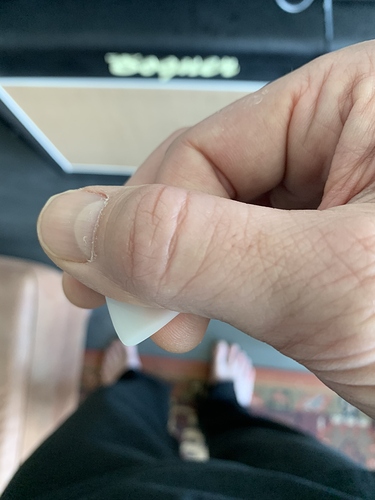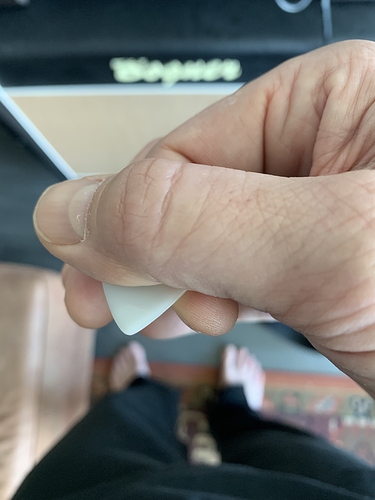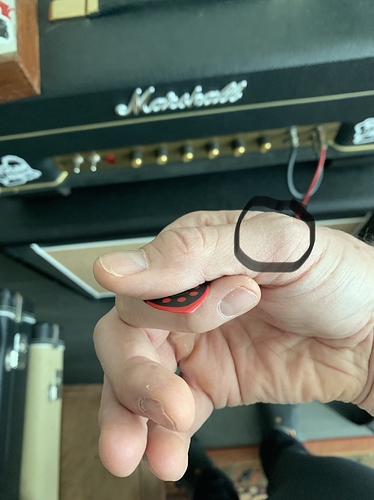Made another Microscopic little discovery that for what ever reason makes a difference in the picking. The first picture is what I normally do and the second one seems to help with lining everything up, feeling more stable, and sounding better. Can you tell the difference? 
Did you get this from the Primer or just through experimentation? Technically, there’s nothing specific about more trigger-style grips that work better or worse than more extended ones. But there may be some interaction with the rest of your setup. For example, a trigger-style grip needs a less supinated arm position, and a more extended grip needs a more supinated one. Match them up like a little family.
A little of both. I’m just tucking in my index finger more and for what ever reason it seems to help with everything over all?  I’ve tried every pick grip imaginable and this is the only one that doesn’t feel awkward for some reason. It’s definitely not automatic though.
I’ve tried every pick grip imaginable and this is the only one that doesn’t feel awkward for some reason. It’s definitely not automatic though.
It’s not just that you’re tucking in the index finger, you’re also moving up the index finger with the thumb. This spectrum of extended index to trigger index is how I see the range of most common grips. Then you throw in middle finger and three finger and you have most of the picture.
When you say awkward are you referring to the grip or the forearm position and picking motion? Because these things are all related but it can be helpful to sort out where the awkwardness is really coming from. It may be that it’s not the grip, but that you’re changing some other aspect of what you’re doing and that’s what feels weird.
I was referring to the grip but I do have issues with the picking motion as well A lot of times. For some reason out of nowhere my motion will start going side to side instead of up and down, and my thumb and index finger will start bending back and fourth instead of staying planted and firm. I’ll start watching what I’m doing to try and correct it, but can’t ever figure it out because I never felt like I made any adjustments in the first place. 
Have you watched this yet? We address exactly the randomness you’re describing:
Short story, the randomness is normal and necessary, because that’s what enables you accidentally do it right. But consistency and smoothness only improves if you can you notice, by feel, when the correct form happens, and reproduce it. If you don’t notice when the correctness happens, you’ll just get stuck in the random stage and never converge on the correct form.
Experts converge because they have great intuition for when they do something correctly. Most of us have some of that. But we typically need more specific instructions for what “correct” looks and feels like, to help us notice.
Yes, great video!! I feel so much of that applies to me. From about the 1:20-35 mark the 3 things you discuss is EXACTLY what happens to me.  that’s what was always a head scratcher. how I can be trucking along smoothly and all the sudden out of nowhere those things start happening. Once it starts there’s no turning back. I almost have to stop for a minute and get the Train back on the rail Road track so to speak. In the video below I’m playing at about the 150-160 range and those are the moments where I feel things are syncing up pretty nicely. The problem are the things I mentioned above start creeping in.
that’s what was always a head scratcher. how I can be trucking along smoothly and all the sudden out of nowhere those things start happening. Once it starts there’s no turning back. I almost have to stop for a minute and get the Train back on the rail Road track so to speak. In the video below I’m playing at about the 150-160 range and those are the moments where I feel things are syncing up pretty nicely. The problem are the things I mentioned above start creeping in.
Generally the interference of other motions is an indication that the motion you’re trying to use isn’t really learned. Your hands are still trying out different things looking for that “click” of positive feedback. The core of the learning process is to notice when it’s working and replicate that form, by feel, without looking. Over time, the feel of the correct form becomes familiar to you and other motions stop intruding.
Couple things. What motion type are you using? Is this USX or DSX? Have you filmed it up close, in slow motion, with good light (open windows are the best), to verify? That’s important. If this is not an escape motion then it needs to be. You don’t have a stringhopping problem and that’s great. We just have to make sure the motion you’re using is actually one that will also work for some type of string switching when you need to do that.
In this Instagram clip, honestly, I would say this sounds unsynchronized. Once you’ve verified the motion is an escape type, next up is hand synchronization. In general, what I would do for this is turn off any external timing sources like metronomes and backing tracks. That just adds confusion. The only synchronization we really care about is between the hands. Then take a simple pattern in a single position on the fretboard, like the Yngwie six-note pattern, or Di Meola sixes, or similar, and do it with an accent on the first note of the pattern. The accent is your metronome. Try that and see if you can lock up at or near your maximum picking speed.
I’ve been studying the EJ cascade pack for the last several years so assumed that I was a USX player. I’m honestly starting to wonder if that’s not the case. I’ve filmed myself in other clips, and it looks to me like my pick is titled upwards. So I’m a guy trying to learn EJ 5’s or things that always switch strings on a upstroke, and I’m a upward pick slanter.  I tried this morning to just play Yngwie type sixes on one string and it was kind of a train wreck. My picking hand just starts having a mind of its own, and starts doing the twitching back and forth between the thumb and index finger, circling around the strings instead of going up and down, and the worse issues of having my thumb hurt which has always been the case when playing things fast. It’s around the bone and joint area in the picture here. For me it Just seems that when my mind goes to “fast mode” things change and all my problems start creeping in. How do you go from the single time picking motion into the fast double time type motion without everything changing physically is what’s stumping me. I’m hoping that I have that breakthrough at faster speeds like what you talk about with Andy Wood in the just going for it video but nothing ever seems to stick. I’ll film myself again to find out 100% if I’m USX OR DSX. As always thanks for your feedback Troy.
I tried this morning to just play Yngwie type sixes on one string and it was kind of a train wreck. My picking hand just starts having a mind of its own, and starts doing the twitching back and forth between the thumb and index finger, circling around the strings instead of going up and down, and the worse issues of having my thumb hurt which has always been the case when playing things fast. It’s around the bone and joint area in the picture here. For me it Just seems that when my mind goes to “fast mode” things change and all my problems start creeping in. How do you go from the single time picking motion into the fast double time type motion without everything changing physically is what’s stumping me. I’m hoping that I have that breakthrough at faster speeds like what you talk about with Andy Wood in the just going for it video but nothing ever seems to stick. I’ll film myself again to find out 100% if I’m USX OR DSX. As always thanks for your feedback Troy.
Don’t look at the “slant” of the pick. For wrist players like you, you can do each type of motion with the same or very similar pickslant and arm position. We’re much clearer about this in our instructional material now, and I apologize for not getting there sooner.
The thing that matters most is what joint you are using (elbow, forearm, wrist, etc.), and second, which type of picking motion you are trying to make with that joint. Not all joints can make all types of pickstrokes, but the wrist, which you are using, can. USX means “usptroke escape”. Does the pick escape on the upstroke? If so, it’s USX wrist motion. If the pick escapes on the downstroke, it’s a downstroke escape wrist motion, or “DSX”, for short.
You don’t. You start with fast and make that work first. Make believe slow mode doesn’t exist. It’s not a thing because it doesn’t represent your most efficient technique. Fast mode is the only mode that’s real. If it’s not at least somewhat working in fast mode, then it’s not working, period. That’s the focus of the “Starting With Speed” video.
I don’t think you’ve watched the Pickslanting Primer, have you? Since you are a wrist player, those are our best instructions for getting those motions happening and we most common grips and arm positions.
Here’s a video I just made of me playing in “fast mode” warts and all. when I get in that mode my pick feels firm and stable which is good I guess, but I tend to tilt the pick pretty far sideways. Not sure if that’s a bad thing. Also I still can’t tell if I’m a USX picker or not from that video? I apologize but that’s about as good as I can film myself. The “Yngwie style lick” video I did 2-3 weeks ago has a better view of that helps you. 
Thanks for filming. This sounds essentially the same to me as “medium mode”, in terms of the synchronization issue. I’m not hearing accents on that initial note of the pattern so it sounds like you really haven’t done the chunking process yet.
If you can’t get the phone closer to your playing, and use slow motion mode, you’ll never really know what kind of pickstroke you’re making. You can totally do it. Masking tape that sucker to the back of a chair or broomstick (or both!) if you have to. A cheap Amazon tripod with a phone mount is handy:
You want the exact height you need to look right down the strings. Once you have that, get up close and point the headstock as much at the lens as you can without your fretting fingers getting in the way.
You don’t want to keep coming back here and having me or others guess. You want to know immediately so that you don’t waste another minute of your valuable guitar time doing the wrong thing or at least not knowing.
Ok sounds good! I’ll figure something out. You’re right about the chunking thing. I have major issues with that. When I play fast I think I get lost where I am to a degree. Would it help to use the 1/2 speed feature on you tube or is that still not visible enough?
The biggest challenge is the framing i.e. camera angle. If you’re not looking down the strings then the perspective can make it hard to know what you’re looking at, even if you’re slowing it down. Once you get a good camera angle, 120fps video will offer much more detailed motion when slowed down. It also has less motion blur. Again, you will need a nice bright daylight room to get the best video at 120.





